ALIEN (1979)
The crew of a spaceship answer a strange distress call, unwittingly bringing a deadly creature back aboard their ship after investigating the source...
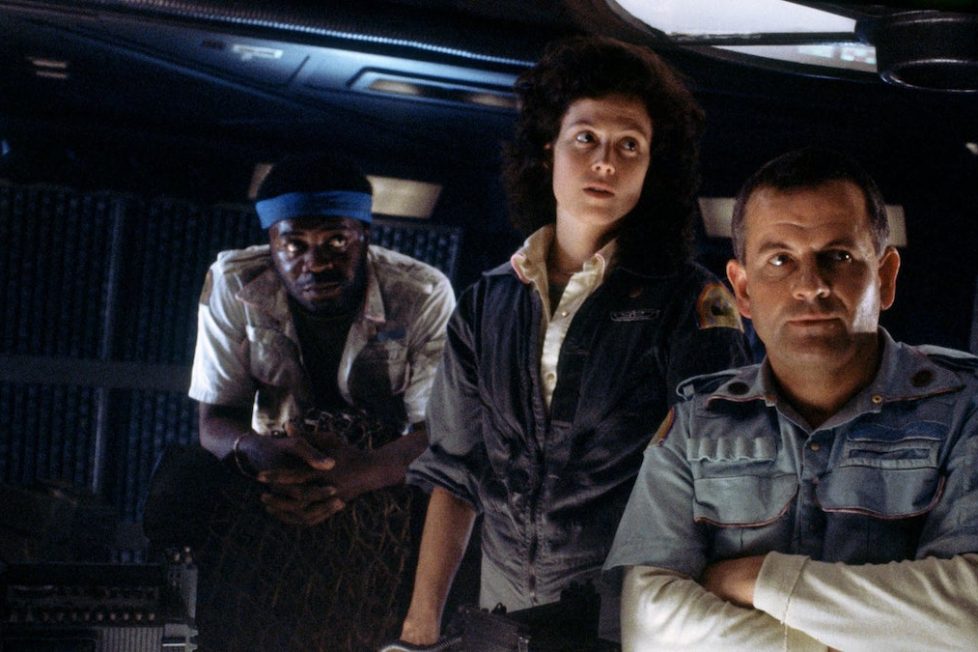
The crew of a spaceship answer a strange distress call, unwittingly bringing a deadly creature back aboard their ship after investigating the source...


We owe a lot to a spray-painted beach ball. That’s what Dan O’Bannon used to create the alien in Dark Star (1974), a low-budget sci-fi comedy “student film” made that he co-wrote with friend John Carpenter to direct. While Dark Star became a surprise success and gained cult status, O’Bannon channelled his frustrations into a script that would essentially redo Dark Star but with horror replacing laughs, unencumbered by only having a $60,000 budget. Fellow screenwriter Ronald Shusett saw an early draft of O’Bannon’s story about a team of astronauts awoken from cryosleep, then titled Memory, and was so excited he set aside his draft of what eventually became Total Recall (1990) to get involved.
Unfortunately, work on Memory was delayed by six months when O’Bannon, also a talented VFX supervisor, was hired to work on Alejandro Jodorowsky’s upcoming adaptation of Frank Herbert’s sci-fi novel Dune. The project eventually fell apart (to be revived by David Lynch several years later), but during his time in Paris developing Jodorowsky’s version, O’Bannon found creative inspiration in the work of three artists: British illustrator Chris Foss, French artist Jean “Moebius” Giraud, and Swiss painter H.R Giger.

Arriving back in Los Angeles after his eye-opening trip to Europe, O’Bannon and Shusett resumed work on their sci-fi screenplay, now known as Star Beast because the idea has evolved to the point where a spaceship was infiltrated by a lethal alien—an idea inspired by an older O’Bannon script about gremlins getting into the engine of a B-17 bomber during WWI. It was around this time that the B Movie-style title was again changed, to the simpler Alien, after O’Bannon noted the number of times that word was used throughout their drafts. A key turning point was when the two friends brainstormed ways for the alien to get inside the spaceship, with Shusett taking credit after waking up with the unsettling notion of the alien having sex with an unwilling crewman by attaching itself to his face and planting a seed.
While this method of parasitic infiltration was fresh and has become Alien’s USP, O’Bannon and Shusett are open about the many other influences on their ideas. The Thing from Another World (1951), which O’Bannon’s pal John Carpenter would remake in 1982, begat the desire to have a claustrophobic environment; Planet of the Vampyres (1965) featured a giant alien’s skeleton, with the one in Alien famously nicknamed the ‘Space Jockey’; a short story by Clifford D. Simak called “Junkyard” is where the chamber of alien eggs originates; and pulp sci-fi classic Forbidden Planet (1956) gave rise to the spaceship landing on another world and its human crew being killed one by one.

Famously pitched as “Jaws in space” to Hollywood studios, the only interest in their finished screenplay came from low-budget horror maestro Roger Corman. Flashbacks to Dark Star’s spray-painted beach ball must have crossed O’Bannon’s mind and he was reluctant to sell Corman his script. Luckily, Alien somehow made it to the attention of a small production company affiliated with 20th Century Fox, called Brandywine. Its three founders—Gordon Carroll, Walter Hill (who later directed The Warriors), and David Giler —quickly signed a deal to make Alien. O’Bannon and Shusett were initially happy but started to get jittery after Hill and Giler demanded rewrites they felt weren’t improving things. They even started to suspect efforts were being made to twist Alien into enough of a different shape that Giler and Hill could plausibly assume full credit for the end product.
They perhaps needn’t have worried because, over the course of eight rewrites at Brandywine, the popular character of android Ash was added by Giler and Hill, who also made the crew’s dialogue flow more naturally. O’Bannon ultimately received sole credit for writing Alien by the Writers Guild of America, but today accepts the many improvements made after selling it to Brandywine. Amusingly, David Giler and Walter Hill were later honoured as “the creators” of androids in the Alien universe through its prequels, Prometheus (2012) and Alien: Covenant (2017), as the two synthetics played by Michael Fassbender are called “David” and “Walter”.
Despite the screenplay being finessed by Giler and Hill’s revisions, 20th Century Fox still wasn’t interested in making Alien because they couldn’t see past its B Movie trappings on the page. That changed when Star Wars (1977) became a cultural phenomenon, sending every studio scrambling to get their own space movies into cinemas while public interest was high. Granted a budget of $4.2M, funded by 20th Century Fox’s British production subsidiary, Alien was officially in development.
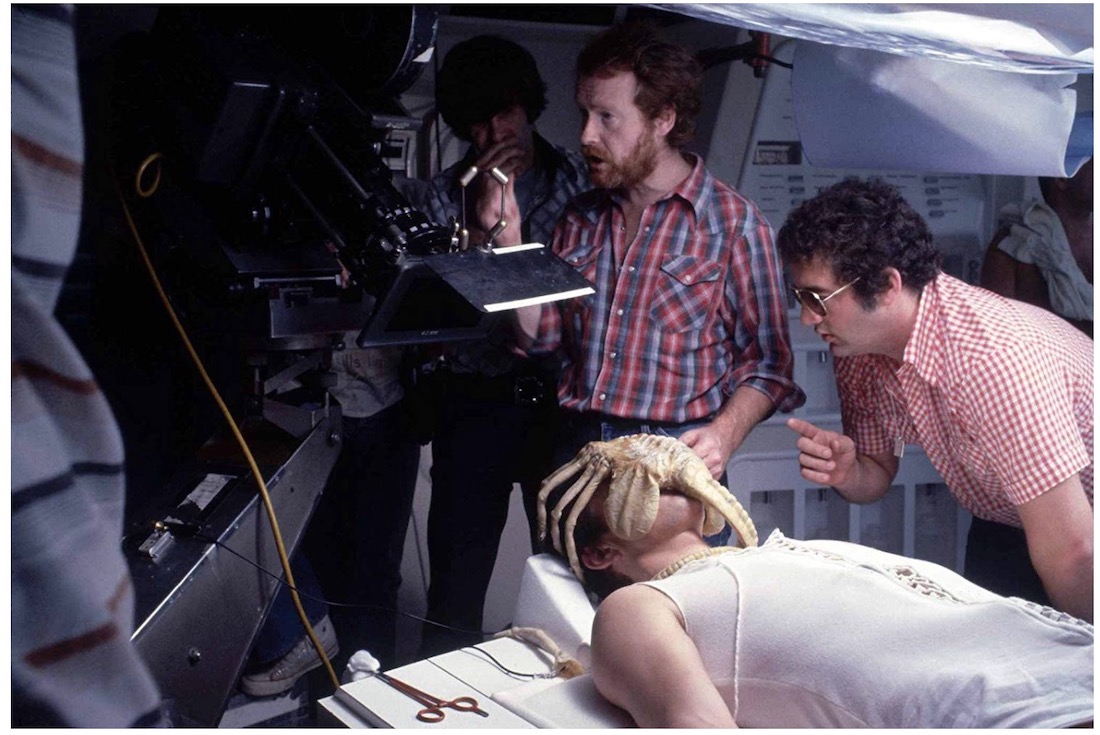
O’Bannon was interested in making his directorial debut with Alien, but Fox wanted to put Hill in charge because he’d already made Hard Times (1975) and The Driver (1978), but he refused due to other commitments. Peter Yates (Bullitt), Robert Aldrich (The Dirty Dozen), and Jack Clayton (The Great Gatsby) were then considered, before a relative unknown called Ridley Scott was offered the job after his debut The Duellists (1977) impressed Giler, Hill, and Carroll.
Coming from a visually-driven advertising background in the UK, Scott immediately accepted the job and began to sketch elaborate storyboards based on the script, which were an aesthetic fusion of 2001: A Space Odyssey (1968) and Star Wars. They alone so impressed the studio that Alien’s budget was doubled to around $9M.
Casting the film was relatively straightforward because the script intentionally kept the gender of each character vague. Scott wanted a “truckers in space” blue collar vibe for the crew of the mining spaceship Nostromo, going further with the ‘used future’ look recently popularised by Star Wars. He wrote long backstories for each character and auditions were held in New York and London, often recorded on tape, before eventually choosing seven actors who were much older than was typical at the time for mainstream thrillers. The two youngest cast members were 30-year-olds Veronica Cartright (Invasion of the Bodysnatchers) and Sigourney Weaver (Annie Hall), the latter of whom would become the human face of the franchise as ‘Final Girl’ survivor Ellen Ripley.
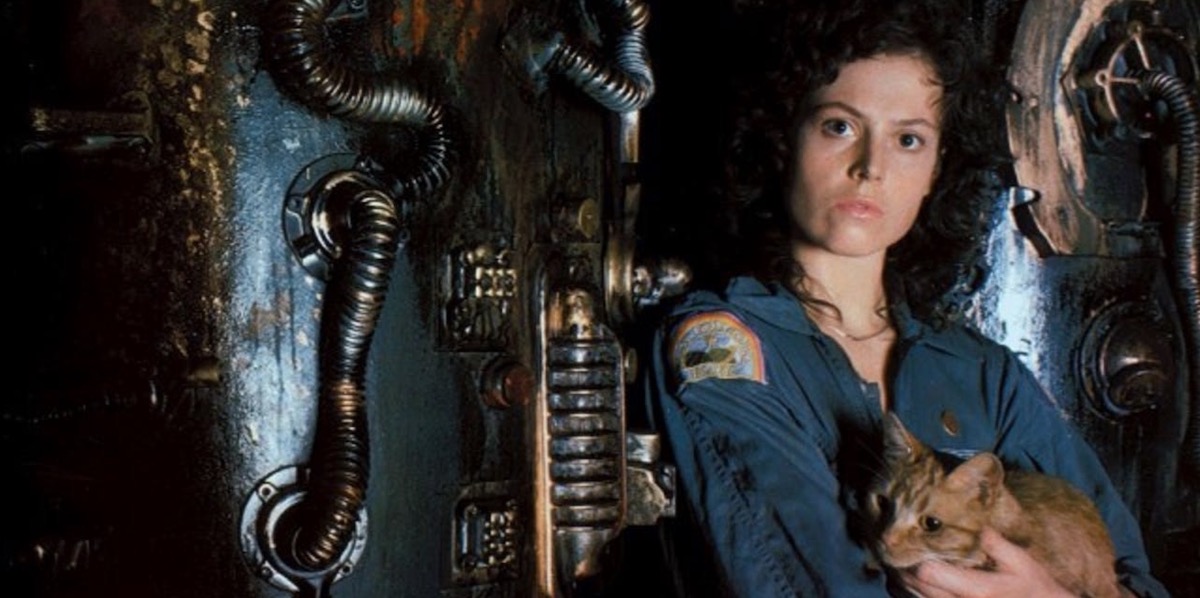
Principal photography at Shepperton Studios near London began on 5 July 1978 and lasted 14 weeks, ending on 21 October. This was an unusually short schedule but Fox wanted to strike while the iron was hot after Star Wars grossed $775M worldwide. Over 200 people worked on Alien during a record-breaking heatwave across the UK, mostly building its three principal sets (the alien planetoid, the Nostromo interiors, the “Derelict” alien ship), all the heavy spacesuits, and the various stages of the Alien xenomorph’s lifecycle.
Interestingly, it was Scott who added the denouement of Ripley fighting the stowaway Alien inside the escape shuttle, after negotiating an increase in funding to shoot this new climax over an additional week. He originally intended the Alien to eventually kill Ripley by biting her head off, ending the film on a downer, but producers vetoed that idea.
H.R Giger’s artwork had inspired O’Bannon to complete his script and sent it down a more nightmarish path, so he was happy to share this major creative influence with Scott. “Necronom IV” was the surrealist piece of Giger’s work they most wanted to bring to life, as it depicted a frightening biomechanical creature with an elongated phallic skull. Giger himself was hired as a designer for the movie after Scott flew to Zürich to convince him to get involved. Fox was concerned Giger’s designs would be too ghastly for audiences accustomed to traditional visions of extra-terrestrials, but Scott got his way and the Swiss visionary flew to London to start work.
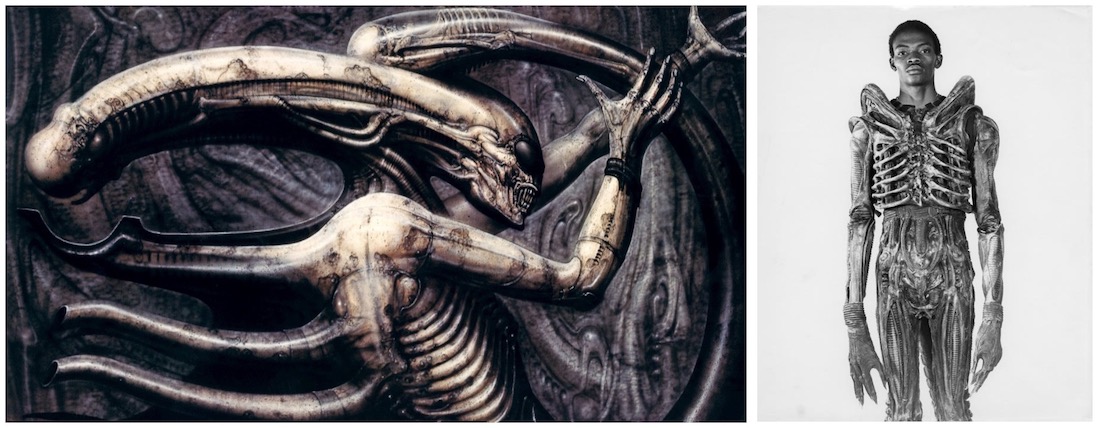
Giger dreamed up all the designs related to the alien ship, the planet, and the “Necronom” creature, which was created by the SFX workshop. A fibreglass egg filled with a cow’s stomach and tripe were used for actor John Hurt to peer into, with Scott himself creating the illusion of movement inside using a pair of rubber gloves. Interestingly, the green lasers in the egg chamber were borrowed from rock band The Who, who were performing on a neighbouring sound stage at the time.
The fan-favourite “facehugger” critter (based on one of the first designs Giger drew for the film) was made by Rob Cobb, who came up with the idea the Alien had acid for blood. Cobb also claims credit for the company name Weylan-Yutani; a corruption of British Leyland Motor Corporation combined with the name of his Japanese neighbour Yutani. Mysteriously, for the 1986 sequel, writer-director James Cameron added a ‘d’ to make it Weyland-Yutani.
The iconic “chestburster” scene, inspired by the Francis Bacon painting “Three Studies for Figures at the Base of a Crucifixion“, was cleverly filmed without the cast knowing what to expect from the finished effect on set. Veronica Cartwright’s reaction is particularly memorable, as a stream of blood was spat directly at her when the razor-toothed creature emerged from Hurt’s bloodied torso.

Of course, the star of Alien is the eponymous creature itself. The monster suit was crafted using snake vertebrae, plasticine, and cooling tubes from a Rolls-Royce, with a separate animatronic head manufactured by Carlo Rambaldi - who was fresh from Close Encounters of the Third Kind (1977) and later built E.T for Steven Spielberg. The Alien headpiece contained 900 moving parts and a piece of a human skull, all smothered in K-Y Jelly. The latex suit was worn by Bolaji Badejo, a 6’10” Nigerian visual artist who took mime classes in order to communicate the alien’s otherworldliness, although Scott opted to keep the creature mostly hidden from view to prevent any chance of it being ridiculed as a cheap “man in a suit”. Scott’s decision to keep the alien mostly in shadow worked and it became an iconic Hollywood monster overnight. The many sequels may have robbed Giger’s design of some mystique, but its look has barely changed over the course of three sequels, two spin-offs, and two prequels because it’s so perfect.
The only part of the design work Scott encountered problems with was the expensive set where the ‘Space Jockey’ corpse is found, as Fox didn’t see the point in wasting money on a gigantic set that only appears briefly. Scott managed to convince them it was a vital part of the storytelling and buildup, so audiences would know Alien was far from being the silly pulp nonsense it sounded like on paper. Giger personally painted that entire set by hand.
The non-alien sets and designs were largely the domain of Ron Cobb and Chris Foss (the illustrator O’Bannon met while developing Dune). Their focus was on the Nostromo ship (named after Joseph Conrad’s 1904 novel), the spacesuits, and the escape shuttle Narcissus (named after Conrad’s 1987 novella The Nigger of the ‘Narcissus). In a pre-digital age, a lot was achieved using miniatures and models, each crafted by VFX supervisor Brian Johnson and supervising modelmaker Martin Bower at nearby Bray Studios.
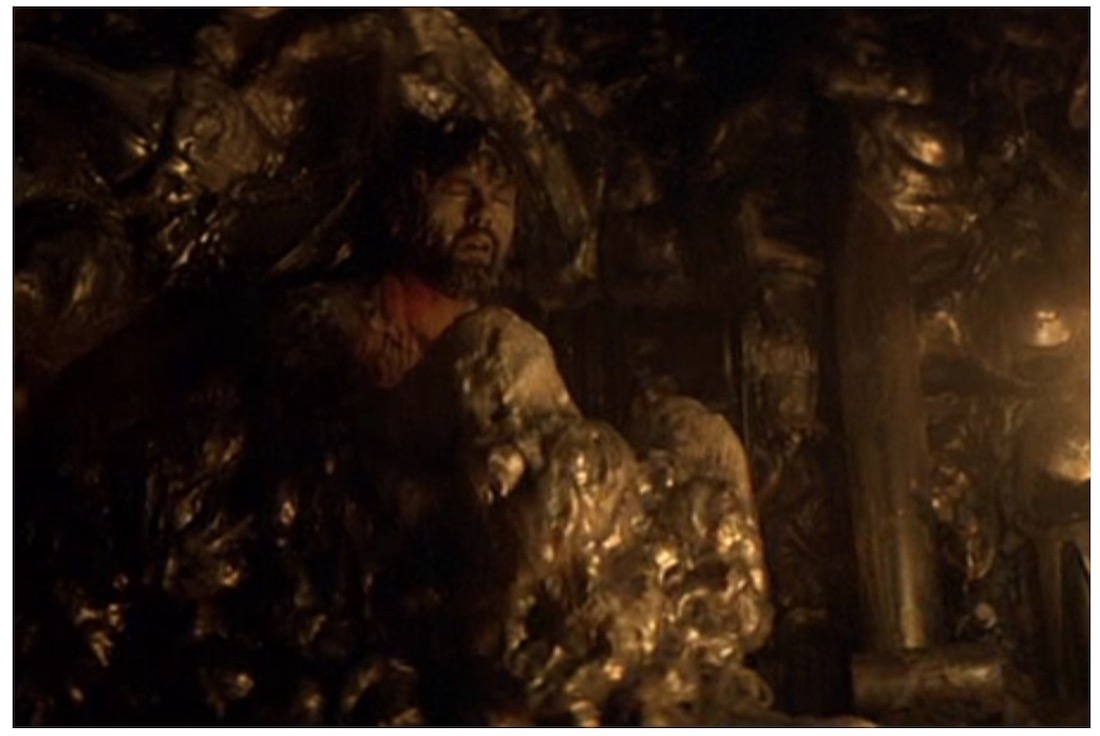
Terry Rawlings (The Duellists) spent 20 weeks editing Alien after principal photography was over, starting from a three-hour rough cut and eventually losing a full hour. Some of the deleted scenes became famous, such as a sequence where Ripley finds some of her shipmates being kept alive in “cocoons”, which was reinstated as part of 2003’s Director’s Cut. Although the cocooning of victims flies in the face of what Aliens (1986) laid out as the canonical lifecycle, based on the ’79 theatrical cut. Although, if you want to get nerdy, fans have suggested cocooning is a rarely-used method to turn prey into Alien Queen eggs to restart the bee-like lifecycle Aliens popularised.
The legendary Jerry Goldsmith wrote the music for Alien, performed by the National Philharmonic Orchestra, although Scott originally wanted Isao Tomita (Prophecies of Nostradamus) because he was a pioneer of “space music”, a sub-genre of new-age music with hypnotic qualities. Goldsmith was a more traditional choice of Fox’s then-President Alan Ladd Jr., so it caused some tension with Scott, with Goldsmith forced by Scott to rewrite his main title them as something more “obvious” in the composer’s opinion. Scott and Rawlings also chopped up some of Goldsmith’s score, to better match the temporary track they’d grown attached to. Nevertheless, Scott later described Alien’s score as “full of dark beauty” and it won the BAFTA for ‘Best Film Music’. Interesting, 13 years after Goldsmith’s death, Scott recycled some of the music cues for his prequel Alien: Covenant.

The first screening of Alien to 20th Century Fox representatives was ruined by sound issues, but a test screening in Dallas with a real audience caused genuine gasps of fear. A series of previews occurred in early 1979 with the iconic tagline “In space, no one can hear you scream” used in promotional materials. Alien premiered on 25 May 1979 in the US, without a red carpet event, and, outside of a September gala performance at the Edinburgh Film Festival, British audiences had to wait until 13 January 1980 to see it! Alien was a huge success around the world, grossing $80M in the US alone and making a grand total estimated at $104M. Maddeningly, Fox had the audacity to claim Alien lost them $2M in an effort to swindle Brandywine out of revenue they were owed. The matter was only settled in 1983 when Fox agreed to bankroll a sequel to Alien.
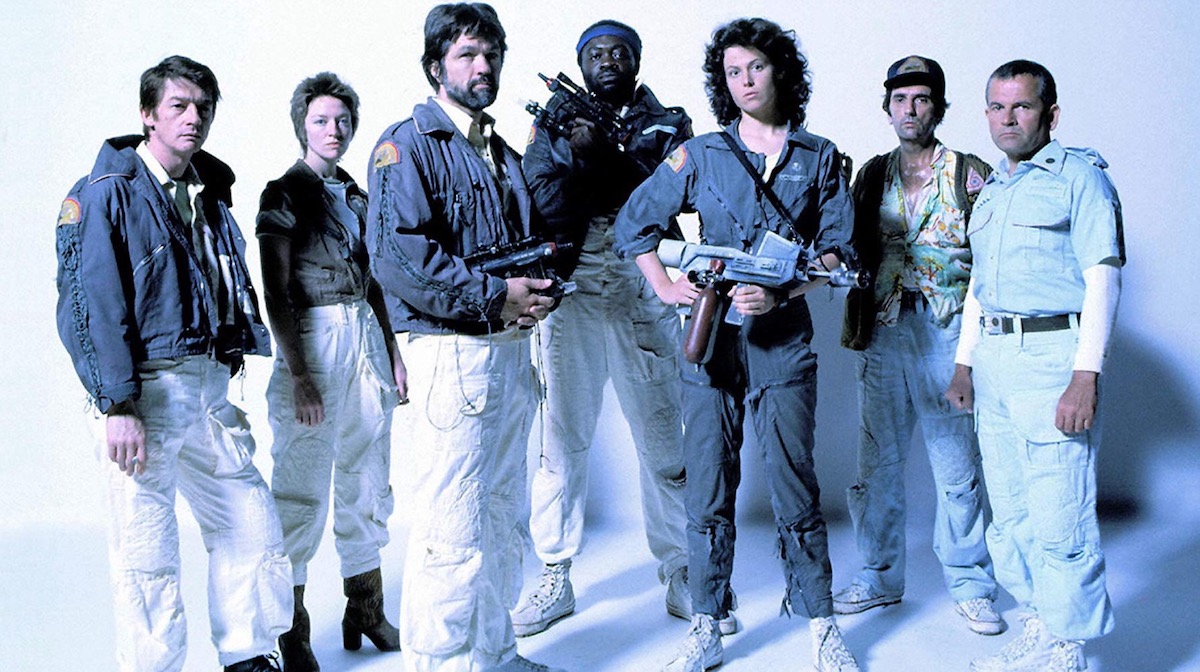
Alien begins with deep space towing ship The Nostromo receiving a distress call from an unexplored, inhospitable planetoid. The crew investigate and discover a crescent-shaped alien ship containing thousands of large eggs - one of which hatches a crab-like “facehugger” and attaches itself to the face of a crewman, Cain (Hurt), and coils a tail tightly around his neck. After the creature later releases its vicelike grip and dies, it becomes apparent Cain’s been impregnated with the creature’s offspring: a penis-shaped critter that bursts free of his rib-cage and escapes into the bowels of the Nostromo, where it rapidly grows into a terrifying eyeless monster with acid for blood…
Alien is an indisputable classic, taking a simple storyline and adorning it with phenomenal designs and compelling actors. Giger was the perfect choice to create the cutting-edge bio-mechanical look for all the alien designs, achieving perfect synergy with Scott’s mastery behind the camera. The whole movie swims in a foreboding atmosphere, while the subtext and extra-terrestrial threat carry potent sexual connotations.
The facehugger disgusts us because it’s a crab-spider effectively having oral sex with an unwilling “mate”, and the adult creature this unholy union creates behaves like a predatory rapist. The alien itself has a phallic head, its slathering mouth evokes the vagina dentata folk tale, and the creature has no eyes to reason with or impart sympathy. In one scene, there’s a shot of the alien’s jagged tail creeping up between the legs of a petrified woman. The subtext is clear. Alien is shot through with allusions to sex and motherhood elsewhere, too: the ship’s computer is known as Mother, the Nostromo’s landing craft detaches from an “umbilicus”, and the hull of the alien craft is studded with portal entrances resembling dilated vaginas.
Alien remains a classic of modern horror sci-fi. It’s the perfect cocktail of a great concept, simple narrative, suffocating tone, pioneering production design, deep themes and subtext, and characters one can identify with. It’s a movie that gets under your skin by stoking male anxiety and fascination with reproduction, and both gender’s fear of sexual violation.

The success of Alien led to a fruitful line of merchandise (toys, figurines, video games, clothes) and a varied lineage of further movies, the individual quality of which is hotly debated. James Cameron’s Aliens is seen as a worthy follow-up that retreads the narrative but with a more action-orientated war movie footing. David Fincher’s Alien³ (1992) was a disappointment hamstring by a tortuous production history, which has been reappraised more positively in recent times. Jean-Pierre Jeunet’s Alien: Resurrection (1997) was a fitfully entertaining but formulaic horror action flick. Ridley Scott returned to the franchise to helm Alien’s aforementioned prequels, which shifted the focus away from the alien to explore grander questions about mankind’s origin and the thorny issues of artificial intelligence. There were even two spin-offs pitting xenomorphs against Predators from 20th Century Fox’s other big alien blockbuster of the ’80s, but the less said about those the better.
Alien itself undoubtedly gave Ridley Scott his big break into Hollywood, at the older age of 42, and he’s barely looked back since. It also brought Sigourney Weaver to wider attention and set her down the path to ’80s super-stardom, becoming a female action icon along the way thanks to this franchise. Giger’s unforgettable designs also encouraged unorthodox thinking about monsters in film and likely inspired John Carpenter’s grosser approach to The Thing (1982), but the Swiss painter’s aesthetic became synonymous with the Alien franchise and never really left that narrow field. The closest Giger came was designing Sil, another biomechanical alien predator, from the movie Species (1995) and its two sequels.
This year, Alien turned 40. Coincidentally, it’s the same age as me. We’ve grown up together and it’s always been one of my favourite movie franchises; a frightening horror story that propelled sci-fi into the modern age and remains the benchmark others aspire to but rarely equal.
director: Ridley Scott.
writers: Dan O’Bannon (story by Dan O’Bannon & Ronald Shusett).
starring: Tom Skerritt, Sigourney Weaver, Veronica Cartwright, Harry Dean Stanton, John Hurt, Ian Holm & Yaphet Kotto.
